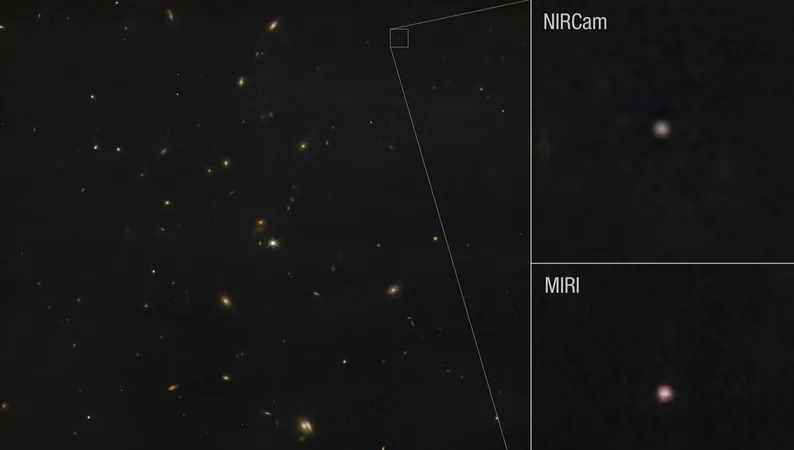
Asteroid 2024 YR4: A 1-In-25 Chance of Striking the Moon - The Spectacle That Could Unfold!
2025-04-08
Author: Jia
Asteroid 2024 YR4: The Potential Collision
Asteroid 2024 YR4 is stirring excitement among planetary scientists as recent predictions suggest it has a 1-in-25 chance of colliding with the Moon. This intriguing celestial object, once thought to pose a greater risk to Earth, now appears more likely to target our Moon.
According to Dr. Andrew Rivkin, a prominent planetary scientist at Johns Hopkins University, there was previously only a 0.5% chance of this asteroid hitting the Moon, which has now escalated to approximately 3.8%. “The odds of an impact into the Moon have always existed, but as the orbit changed, it moved toward the Moon instead of the Earth,” Dr. Rivkin noted. This means that while there's a better than 96% chance it will miss the Moon, the prospect of a collision is nonetheless an electrifying thought!
Unraveling the Mysteries with JWST
To prepare for potential scenarios involving 2024 YR4, Dr. Rivkin’s team reached out for telescope time on the James Webb Space Telescope (JWST). This cutting-edge infrared telescope is a collaborative project by NASA, the European Space Agency, and the Canadian Space Agency. The data collected has significantly improved our understanding of 2024 YR4’s orbit, increasing focus on its physical characteristics, which are estimated to range from 53 to 67 meters (174 to 220 feet).
“It would be an incredible opportunity for scientific observation if nature permits,” Dr. Rivkin remarked. The team employed unique measurements to account for 2024 YR4's rapid spin rate of about 20 minutes, gaining new insights into not just its size, but its overall shape as well.
The Potential Gift of a New Lunar Crater
Regardless of whether 2024 YR4 ultimately becomes a threat to Earth or the Moon itself, it offers crucial information about near-Earth objects overall. Dr. Rivkin highlighted the potential scientific benefits of an impact: “A collision would create a new observable crater on the Moon, which could be a remarkable natural experiment.”
Should an impact occur, scientists predict that it could generate a crater around 1 kilometer (0.6 miles) wide, producing a brief but stunning flash visible from regions across the Americas, the Pacific, and Asia. The event could not only create a lunar crater but generate lunar meteorites that may eventually return to Earth—though, fortunately, these would pose no danger to us.
Richard Moissl, head of ESA’s Planetary Defence Office, elaborated: “Definitely, observing a new Moon crater would be the outcome!” It's an exciting prospect that could enrich lunar science if researchers are equipped with seismometers to explore the lunar interior after an impact.
Continuing Observations of 2024 YR4
Anticipation builds as more observations are set with JWST later this spring. These observations aim to further refine our understanding of the asteroid's physical properties and orbit. Presently too faint for ground-based telescopes, 2024 YR4 will continue to be monitored closely, whether it collides with the Moon or not.
Dr. Rivkin emphasized our preparedness for potential space threats, stating, “The efforts to track these objects are indicative of an effective system. We discovered 2024 YR4 early enough to gather important measurements. Even though it isn't heading toward Earth in 2032, our readiness demonstrates a robust response plan should a genuine threat arise.”
In a world captivated by the mysteries of the cosmos, the saga of Asteroid 2024 YR4 presents both excitement and intrigue—reminding us that the universe still holds many secrets waiting to be uncovered!



 Brasil (PT)
Brasil (PT)
 Canada (EN)
Canada (EN)
 Chile (ES)
Chile (ES)
 Česko (CS)
Česko (CS)
 대한민국 (KO)
대한민국 (KO)
 España (ES)
España (ES)
 France (FR)
France (FR)
 Hong Kong (EN)
Hong Kong (EN)
 Italia (IT)
Italia (IT)
 日本 (JA)
日本 (JA)
 Magyarország (HU)
Magyarország (HU)
 Norge (NO)
Norge (NO)
 Polska (PL)
Polska (PL)
 Schweiz (DE)
Schweiz (DE)
 Singapore (EN)
Singapore (EN)
 Sverige (SV)
Sverige (SV)
 Suomi (FI)
Suomi (FI)
 Türkiye (TR)
Türkiye (TR)
 الإمارات العربية المتحدة (AR)
الإمارات العربية المتحدة (AR)